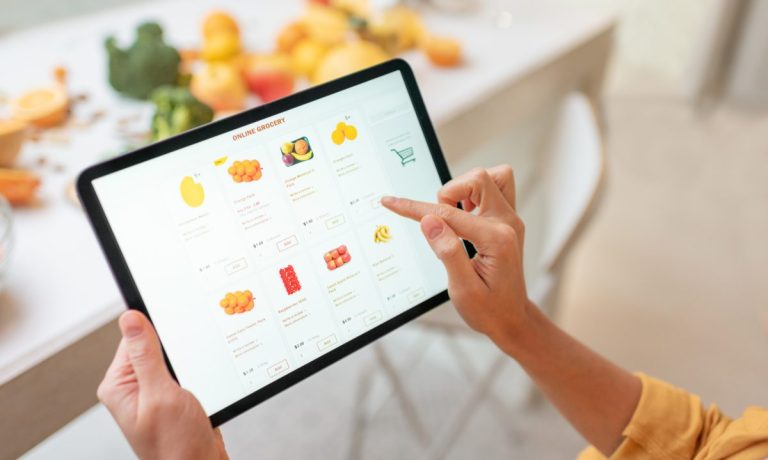Forage Takes On Stalwarts to Gain Slice of $100B Online SNAP Payments Opportunity

Integrating Supplemental Nutrition Assistance Program (SNAP) Electronic Benefits Transfer (EBT) payments into eGrocery platforms while complying with federal and local regulations is no easy feat, which is why only three third-party payment processors (TPPs) have managed to do so.
Against this backdrop, one such TPP, Forage, announced last week (Aug. 8) that it has raised $22 million in its Series A funding round. This fundraise may help the company compete against the other two — FinTech giants FIS and Fiserv — in offering U.S. Department of Agriculture (USDA) approved solutions for digital SNAP EBT payments.
The company’s co-founder and CEO Ofek Lavian, who previously spearheaded payments products for eGrocery giant Instacart and before that worked on payments products for Uber, spoke with PYMNTS’ Karen Webster about the present and future of the technology. He cited the example of Instacart, where sentiment was initially split.
“There were two opposing thoughts within Instacart when we initially wanted to launch this. One of them was, hey, are people on EBT ever going to order groceries online? Why would they do that? Why would they pay the premium for delivery?” Lavian said. “Instacart’s traditional consumer base is suburban affluent, middle aged. It skews women. The other school thought was, no, this is really core to our mission.”
He added that, contrary to the former argument, it turned out that there is an audience for the technology, given that many SNAP EBT participants live in areas where the nearest stores do not offer healthy foods and that they are disproportionately likely to have disabilities, making delivery options all the more necessary.
By the Numbers
The opportunity here for grocers and for eCommerce platforms facilitating these online transactions is significant. The USDA’s SNAP National Level Annual Summary of Participation and Costs finds that, in 2021, there were 41.6 million participants amounting to roughly $109 billion in annual benefits.
Moreover, it seems there is considerable untapped demand for online grocery, considering the extent to which adoption lags behind other retail categories. The July edition of PYMNTS’ ConnectedEconomy™ series, “The ConnectedEconomy™ Monthly Report: The Rise of the Smart Home,” which drew from a May survey of more than 2,600 United States consumers, found that nearly two-thirds of consumers ordered from an online marketplace such as Amazon, eBay or Etsy in the previous month. In contrast, only 40% ordered groceries online for delivery in the same period.
Get the study: The Rise of the Smart Home
Lavian noted that SNAP EBT recipients are ready to engage with eGrocery channels. He recalled that, at the time of Forage’s founding, the company aimed to build “a consumer app to help people purchase groceries more affordably,” only to find out that “people on food stamps actually know how to do that pretty well” already.
If You Build It
Given the existing demand for digital options for SNAP EBT recipients, Lavian stated that these consumers “correctly realized that the actual biggest unmet need in the entire ecosystem” was the need for technology that would make it possible to spend these benefits online.
He explained that the first digital SNAP EBT purchase was not made until 2019 and that, because of the logistical challenges of getting government approval to enable these purchases, it remains difficult for many eGrocers to add SNAP EBT acceptance.
As such, Lavian noted that the company not only builds the financial infrastructure to make these transactions possible but also plays “an advisory role” for grocers not only to assist them in implementing the technology but also to “help them meet the regulatory requirements.” Additionally, Lavian offers his advice on “how to build a successful program” and how to boost customer acquisition.
The Devil in the Details
Much of the difficulty of implementing this technology comes from the granularity it requires. Unlike most payment methods which work the same no matter what the shopper is purchasing, SNAP EBT can only be used on certain items, meaning that it requires data about each SKU and whether or not it is eligible. Granted, online grocers do not need to reinvent the wheel there.
“Luckily for the industry, that process has existed for decades for the in-store transactions,” Lavian said. “So, for many of the large retailers, … you’re able to leverage their existing catalog where they already track this data.”
Additionally, SNAP EBT purchases require PIN codes for every purchase, and given that families may share an EBT card, systems that process these payments online need to be able to enable purchases from multiple household members.
Down the line, Forage envisions this technology extending beyond SNAP EBT to other ways of accessing government benefits.
“Our mission is to democratize access to government benefits,” Lavian said, “and for us, SNAP is an absolutely critical first step, but we’ve got some pretty big aspirations beyond that.”